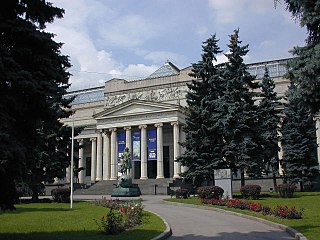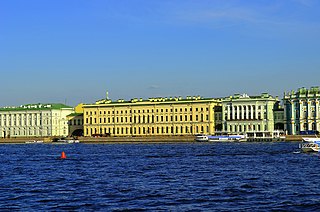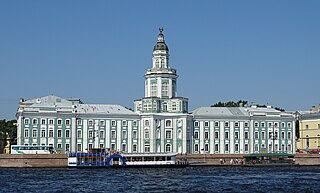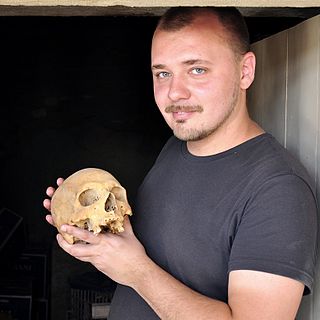
The Pushkin State Museum of Fine Arts is the largest museum of European art in Moscow. It is located in Volkhonka street, just opposite the Cathedral of Christ the Saviour. The International musical festival Sviatoslav Richter's December nights has been held in the Pushkin Museum since 1981.

The State Hermitage Museum is a museum of art and culture in Saint Petersburg, Russia. It was founded in 1764 when Empress Catherine the Great acquired a collection of paintings from the Berlin merchant Johann Ernst Gotzkowsky. The museum celebrates the anniversary of its founding each year on 7 December, Saint Catherine's Day. It has been open to the public since 1852. The Art Newspaper ranked the museum 10th in their list of the most visited art museums, with 2,812,913 visitors in 2022.

The Museum of Egyptian Antiquities, commonly known as the Egyptian Museum, located in Cairo, Egypt, houses the largest collection of Egyptian antiquities in the world. It houses over 120,000 items, with a representative amount on display. Located in Tahrir Square in a building built in 1901, it is the largest museum in Africa. Among its masterpieces are Pharaoh Tutankhamun's treasure, including its iconic gold burial mask, widely considered one of the best-known works of art in the world and a prominent symbol of ancient Egypt.

The Pergamon Museum is a listed building on the Museum Island in the historic centre of Berlin, Germany. It was built from 1910 to 1930 by order of Emperor Wilhelm II and according to plans by Alfred Messel and Ludwig Hoffmann in Stripped Classicism style. As part of the Museum Island complex, the Pergamon Museum was added to the UNESCO World Heritage List in 1999 because of its architecture and testimony to the evolution of museums as architectural and social phenomena.

The Kunstkamera or Kunstkammer is a public museum located on the Universitetskaya Embankment in Saint Petersburg, facing the Winter Palace. Its collection was first opened to the public at the Summer Palace by Peter the Great in 1714, making it Russia's first museum. Enlarged by purchases from the Dutch collectors Albertus Seba and Frederik Ruysch, the museum was moved to its present location in 1727. Having expanded to nearly 2,000,000 items, it is formally organized as the Russian Academy of Science's Peter the Great Museum of Anthropology and Ethnography, abbreviated in Russian as the МАЭ or МАЭ РАН.

The Royal Cache, technically known as TT320, is an Ancient Egyptian tomb located next to Deir el-Bahari, in the Theban Necropolis, opposite the modern city of Luxor.

Boris Alexandrovich Turayev was a Russian scholar who studied the Ancient Near East. He was admitted into the Russian Academy of Sciences in 1918.

Vladimir Semyonovich Golenishchev, formerly also known as Wladimir or Woldemar Golenischeff, was one of the first and one of the most accomplished Russian Egyptologists. He was one of the founders of the Cairo School of Egyptology and one of the most recognized authorities of the schools of Assyriology and Egyptology in Russia.

The National Archaeological Museum is a archaeology museum in Madrid, Spain. It is located on Calle de Serrano beside the Plaza de Colón, sharing its building with the National Library of Spain. It is one of the National Museums of Spain and it is attached to the Ministry of Culture.

H'ART Museum is an art museum located on the banks of the Amstel river in Amsterdam. Formerly a satellite of the Hermitage Museum of Saint Petersburg, Russia, the museum cut ties with the Hermitage after the Russian invasion of Ukraine in 2022.

The Department of Ancient Egypt is a department forming an historic part of the British Museum, with Its more than 100,000 pieces making it the largest[h] and most comprehensive collection of Egyptian antiquities outside the Egyptian Museum in Cairo.

Peter Alexandrovich Saburov was a Russian diplomat, collector of ancient Greek sculpture and antiquities, and a strong amateur chess player and patron of chess tournaments, as an honorary President of the St Petersburg Chess Club.

Vasily Vasilievich Struve was a Soviet orientalist from the Struve family, the founder of the Soviet scientific school of researchers on Ancient Near East history.

Universitetskaya Embankment is a 1.2 km long embankment on the right bank of the Bolshaya Neva, on Vasilievsky Island in Saint Petersburg, Russia. Starting at the Spit of Vasilievsky Island, it spans between Palace Bridge and Blagoveshchensky Bridge.

The History Museum of Armenia is a museum in Armenia with departments of Archaeology, Numismatics, Ethnography, Modern History and Restoration. It has a national collection of 400,000 objects and was founded in 1920. Of the main collection, 35% is made up of archaeology-related items, 8% is made up of ethnography-related items, 45% is made of numismatics-related items, and 12% is made up of documents. It is regarded as Armenia's national museum and is located on Republic Square in Yerevan. The state financially supports the museum and owns both the collection and the building. The museum carries out conservation and restoration work and publishes works on Armenian architecture, archaeology, ethnography, and history. They also have published a series of reports on archaeological excavations since 1948. The museum carries out educational and scientific programs on Armenian history and culture as well.

The Fabergé Museum is a privately owned museum located in the German spa city of Baden-Baden exhibiting different collections, among them, items made by the Russian jewellery firm Fabergé, as well as Fauxbergé pieces. It was opened by Russian art collector Alexander Ivanov on 9 May 2009. It is owned by the private limited company Fabergé Museum GmbH, which was originally co-founded by Alexander Ivanov and Konstantin Goloshchapov in January 2008.

Quay with Sphinxes is a quay at the Universitetskaya Embankment in Saint Petersburg, in front of the Imperial Academy of Arts. It is remarkable for the two ancient sphinxes that were brought from Egypt to Russia at the height of Egyptomania in 1832. The quay was completed in 1834.

The Institute of Oriental Manuscripts (IOM) of the Russian Academy of Sciences, formerly the St. Petersburg Branch of the Institute of Oriental Studies of the Russian Academy of Sciences, is a research institute in Saint Petersburg, Russia that houses various collections of manuscripts and early printed material in Asian languages, including Arabic, Chinese, Mongolian, Tibetan, and Tangut.

Saint Petersburg – second-largest city in Russia. An important Russian port on the Baltic Sea, it has the status of a federal subject. Its name was changed to "Petrograd" in 1914, then to "Leningrad" in 1924, and back to Saint Petersburg in 1991.

Victor Victorovich Solkin is a Russian historian (Egyptology), museologist, lecturer, founder and leader of the Association for the Study of Ancient Egypt MAAT.





















